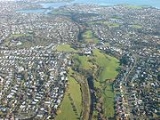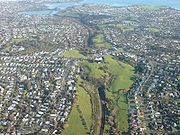
Eastern Transport Corridor
Encyclopedia

Auckland
The Auckland metropolitan area , in the North Island of New Zealand, is the largest and most populous urban area in the country with residents, percent of the country's population. Auckland also has the largest Polynesian population of any city in the world...
, New Zealand
New Zealand
New Zealand is an island country in the south-western Pacific Ocean comprising two main landmasses and numerous smaller islands. The country is situated some east of Australia across the Tasman Sea, and roughly south of the Pacific island nations of New Caledonia, Fiji, and Tonga...
, is a transport reserve along a strip of land and water some of which is occupied by housing, commerce, industry and local roads. It runs adjacent to the North Island Main Trunk Railway freight and passenger railway line, but is earmarked for major transport intensification to improve links from central Auckland to eastern suburbs such as Pakuranga
Pakuranga
Pakuranga is an eastern suburb of Auckland, in northern New Zealand. Pakuranga covers a series of low ridges and previously swampy flats, now drained, that lie between the Pakuranga Creek and Tamaki River, two estuarial arms of the Hauraki Gulf...
and Howick
Howick, New Zealand
Howick is an eastern suburb of Auckland, New Zealand, forming part of what is sometimes called East Auckland. Due to the relatively numerous remaining heritage buildings and other historical remnants from its early European settlement past, it has been called "perhaps Auckland's most historically...
.
Historically, it was to provide the route for an additional motorway connecting through the Isthmus from the east into the Auckland CBD
Auckland CBD
The Auckland CBD is the geographical and economic heart of the Auckland metropolitan area. Bounded by several major motorways and by the harbour coastline in the north, it is surrounded further out by mostly suburban areas...
, with an estimated cost of up to $4 billion, but political and local community resistance made the project fail in the 2000s. The NZTA
New Zealand Transport Agency
The New Zealand Transport Agency is a New Zealand Crown entity tasked with promoting safe and functional transport by land, including the responsibility for driver and vehicle licensing and investigating rail accidents. It was created on 1 August 2008 by the Land Transport Management Amendment...
designations remain in place as of 2010.
Original designs
A strategy study in 2002 stated a need for a new motorway to be built in the corridor (as had been planned decades ago) for a variety of reasons including the need to make suburban streets safer and less polluted. In March 2004 Auckland City Mayor John BanksJohn Banks (New Zealand)
John Archibald Banks, CNZM QSO is a New Zealand politician. He served as Mayor of Auckland City for two terms, from 2001 to 2004, and from 2007 to 2010...
proposed a massive motorway scheme through Hobson Bay. There was substantial community and political resistance to the motorway scheme, largely due to the extreme cost of the proposal (equivalent to four years of the entire country's transport funding budget) and the impact it would have on a number of established neighbourhoods, as well as areas like Tamaki Drive, the Parnell Baths and several environmentally sensitive areas. However, there were also groups that defended it, citing the projected economic gains, and the benefit it would have on the traffic volumes on Tamaki Drive. John Banks proposed to underground large sections of the scheme (earning it the nickname 'tunnelway' amongst some commentators) and proposed to pay for the construction costs at least partly by selling Auckland City's 25% shareholding in Auckland International Airport, and by charging a $5 toll.
In 2002, it was also proposed by John Banks that the Eastern Transport Corridor might link into a harbour tunnel starting north of Parnell, and linking to Ngataringa Bay near Devonport, for an estimated cost of $1 billion.
Revised designs
Many spoke out against the project, including figures such as the former Auckland City Mayor Christine FletcherChristine Fletcher
Christine Fletcher, QSO is an Auckland Council councillor and also prominent for her former New Zealand politics positions, both in Parliament and as Mayor of Auckland City. She was the second woman to serve as mayor of Auckland...
, who argued out that the proposed motorway barely featured in the statutory policy documents, that Councillors lacked needed information to make informed decisions about it, and that the intended growth areas of the city would not require the corridor, with a public transport route being preferable.
A revised plan published on 25 August 2004 reduced the number of lanes substantially (2-3 lanes + bus lane in each direction depending on the section), reducing the financial and ecological impact. Banks said he hoped the scheme would be acceptable to the opponents of the scheme, even though around 1,200 houses would still have to be demolished or otherwise affected. The Purewa Creek section was to be aligned on an elevated expressway to avoid damage to the environmentally sensitive area, while the motorway would be sunk into trenches in Glen Innes
Glen Innes, New Zealand
Glen Innes is a suburb located in Auckland, New Zealand. It is located nine kilometres to the east of the city centre, close to the waters of the Tamaki River.The main streets in Glen Innes are Line Road and Apirana Avenue, which meet at a roundabout...
to reduce disruption. Depending on the connection to the CBD, the scheme would have either entered the city on a widened western Tamaki Drive section after crossing Hobson Bay, or gone through a tunnel under Parnell - which politicians promised would reduce much of the effects on Parnell residents.
However the impacts were still high, and the costs rising (with a worst case estimate of NZ$3.9 billion), and at that point the corridor was fast becoming a political boondoggle
Boondoggle (project)
A boondoggle is a project that is considered to waste time and money, yet is often continued due to extraneous policy motivations.- Etymology :...
.
The proposed motorway was one of the principal points of contention in the 2004 local body elections and contributed to the defeat of Banks. It also led to the election of two councillors from the Action Hobson
Action Hobson
Action Hobson were a centrist council ticket in the Hobson Ward of Auckland City, New Zealand. They were formed to combat the proposed Eastern Transport Corridor by then Mayor of Auckland City, John Banks , and his supporting Citizens and Ratepayers Now bloc.-History:In the October 2004 election,...
protest group who were elected primarily on the promise to stop the new motorway.
The Auckland City Council transport and urban linkages committee decided on 10 December 2004 to scrap the planned motorway component in favour of improved public transport and increased capacity on existing local roads. However the transport reserve remains in place, allowing for the motorway to potentially be undertaken at some point in the future if it becomes economically and politically feasible. Additionally, the Council has undertaken to begin a program to purchase a small number of the most affected properties along the route.
Alternative proposals
Based on this strong opposition to a major link through this area of eastern Auckland, the new AMETI (Auckland-Manukau Eastern Transport Initiative) project now intends to primarily improve the connections of this area towards the south-east (Manukau City), via less problematic routes. The new roads and public transport links are to serve intensified residential and mixed developments like the Mount Wellington Quarry area. In 2010, it was revealed that the updated AMETI plans now included much stronger bus priority proposals than before.Legal status
The designations for the Eastern Transport Corridor still exist as of 2011. Various proposals over the year (such as in 2006, initiated by Action HobsonAction Hobson
Action Hobson were a centrist council ticket in the Hobson Ward of Auckland City, New Zealand. They were formed to combat the proposed Eastern Transport Corridor by then Mayor of Auckland City, John Banks , and his supporting Citizens and Ratepayers Now bloc.-History:In the October 2004 election,...
) did not end in removal, partly because it was argued that the designations were needed for future proofing for the city's growth, and also because other transport links, such as another rail track, or busways, could be needed.
External links
- Auckland Manukau Eastern Transport Initiative (Auckland Transport webpages on the AMETI scheme, which is, in part, a successor project)

